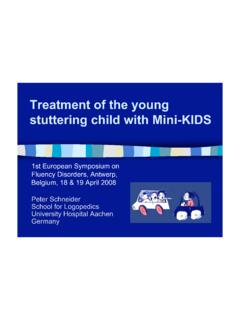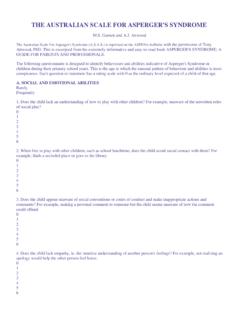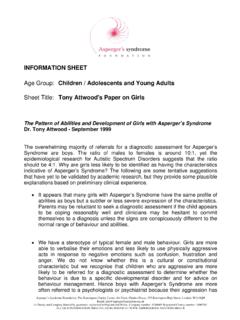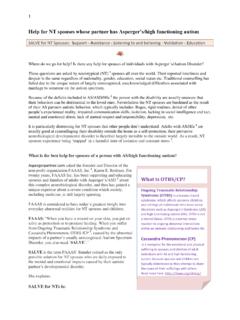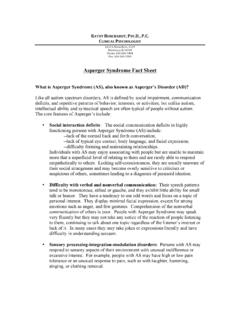Transcription of Fluency disorders and Asperger Syndrome Are …
1 Fluency disorders ANDASPERGER Syndrome Asperger Syndrome ARE they stuttering ?EUROPEAN SYMPOSIUM ON Fluency DISORDERSFRIDAY MARCH 9 2012 Autism spectrum disorderAutism spectrum disorderAutismPervasive Developmental DisorderPDD NOSA utismAsperger SyndromeRett s SyndromeAUTISM SPECTRUM DISORDERP rofound (severe) Autism Moderate Mild (High Functioning) Asperger SyndromePDD NOSC hildhood Disintegrative DisorderAutism SpectrumMeasured Mental disability GiftedSocial- Emotional InteractionAloof Passive Active but OddCommunicationNon-verbal VerbalMotor skillsUncoordinated CoordinatedSensoryHypo HyperWHAT IS Asperger Syndrome ?
2 WHAT IS Asperger Syndrome ? Asperger Syndrome (AS) is a disorder described in DSM-IV has having:qualitative impairment in social interactionDEFINITION restricted repetitive and stereotyped patterns of behaviourinterests and activities causing clinically significant impairments in several areas of functioningan unusual prosody and pitch and motor mannerisms are also observedDSM-IVBackground Our earliest understanding of Asperger Syndrome (AS) is attributed to Hans Asperger a Viennese physician. In 1944, Asperger described a group of children Asperger described a group of children who exhibited social peculiarities and social isolation, albeit with average cognitive and language development.
3 Based on these characteristics, Asperger stated that his sample represented an independent and distinct clinical condition (Miles & Simpson, 2002, p. 132).Hans AspergerHans AspergerCOMMON TRAITS & CHARACTERISTICS socially awkward and clumsy naive and gullible unaware of others' feelings unable to carry on conversation easily upset by changes literal in speech and understanding sensitive to loud sounds, lights, odors fixated on one subject or objectCOMMON TRAITS & CHARACTERISTICS physically awkward in sports very accurate memory for details trouble understanding things they have heard or read inappropriate body language & expression inappropriate body language & expression repetitive and irrelevant comments unusually loud, high or monotonous voice rock.
4 Fidget or pace while concentratingWHAT CAN CAUSE ALL THIS?*NOT BAD PARENTING! Genetics (still a lot of research in Progress) Family inheritance on father s side Neurologic studies Neurologic studies Right lobe studies using MRI s Research done in 1994 and 1995 Disability with right hemisphere Right front lobe especially deals with social rules Other Findings Birth problems, lack of oxygen central nervous system dysfunctionIncidence Rates 48 out every 10,000 children(Kadesjo, Gillberg, & Nagberg, 1999)(Kadesjo, Gillberg, & Nagberg, 1999) Fluency disorderFluency disorderDiagnostic criteria for stuttering (DSM IV - TR)A. Disturbance in the normal fluencyand time patterning of speech (inappropriate for the individual's age), characterized by frequent occurrences of one or more of the following:(1) sound and syllable repetitions(2) sound prolongationsDEFINITION(2) sound prolongations(3) interjections(4) broken words ( , pauses within a word) (5) audible or silent blocking(filled or unfilled pauses in speech) (6) circumlocutions(word substitutions to avoid problematic words) (7) words produced with an excess of physical tension (8) monosyllabic whole-word repetitions( , "I-I-I-I see him")B.
5 The disturbance in Fluency interferes with academic or occupational achievement or with social If a speech-motor or sensory deficit is present, the speech difficulties are in excess of those usually associated with these CAN CAUSE ALL THIS?*NOT affright! Genetics (still a lot of research in Progress) recovered stuttering may be less genetically controlled, with evident but less prominent family history, governed perhaps equally by genetic and environmental factors (Yairi & Ambrose, 2005; 307) Studies of brainWhile the nature of the genetic transmission is still being investigated, parallel areas of research suggest that the onset of stuttering may be related to some underlying structural and or functional differences in the brain (Foundas et al.)
6 , 2000; Fox et al., 2000; Sommer et al., 2002). Other Findings EnvironmentIncidence RatesFluency disorders affect nearly 1% of the world populationwith a range of to a range of to (Bloodstein & Bernstein Ratner, 2008, Yairi&Ambrose, 2005)Lees & Stark (2005) cite a study by Craig et al. (2002), which reports it to be typesDisfluencies typesDisfluencies typesYairi & Ambrose (1990)The Illinois Disfluency Classification System stuttering -like disfluencies Part-word repetition (may-may-maybe) Part-word repetition (may-may-maybe) Single syllable whole word repetitions (I,I,I) Disrhythmic phonations (blocks; prolongations)Disfluencies typesYairi & Ambrose (1990) Other disfluencies Interjections Multiple-syllable word and phrase repetitions (under, Multiple-syllable word and phrase repetitions (under, under.)
7 I want, I want some chips) Revisions or abandonned utterances (I want water, no, I mean juice) Atypical disfluencies Final syllable repetition (baseball-ball) Final part word repetition (dog-og-og) Within-word breaks (fo_od)MethodologyMethodologyAims of the studyIt was not clear if their were stuttering or if it was some vocal maneirismThe purpose of this study is to describe the speech disfluencies in three young children with ASTo clarify if it their speech has really disfluencies according to stuttering definitionParticipants Three male subjects (aged 6 years, 9 years and 14 years) Native speakers of Portuguese languageAll have the formal diagnosis of AS All have the formal diagnosis of AS None had SLT before Referred for Speech and language therapy because they might have a disfluency disorderParticipantsAssessment & Procedure Analyzed according to the stuttering Severity Index fourth edition (SSI-4) Speech sample was collected through video recording Pannasonic VDR D150 DiscussionDiscussionDiscussion There are few written reports about AS and stuttering Nyeggenet al (2001)
8 Individuals with high functioning autism or AS produce repetitions and revisionson 25% as opposed to 14% of utterances produced by a as opposed to 14% of utterances produced by a neurotypical comparison Both typical and atypical disfluencieshave been documented in children and ASD (Sisskin, 2006; Sisskin & Scott 2007) Hietala& Spiller described disfluency patterns Hietala& Spiller described disfluency patterns observed in boys with ASD. Final syllable repetition, final part word repetition and within-word breaks Scott et al (2007) provided a description of the disfluencies observed in individuals with AS and ADHD and noted atypical disfluenciesspecifically repetitions, prolongations and blocks in the word and in the syllable final positionDiscussionPlexico, Cleary, McAlpine & Plumb (2008) found thatchildren with ASD not only experiencedotherdisfluencies and stuttering -like disfluenciesThey also hadatypical disfluenciesthat are notusually observed in children wit typical languagedevelopment and children with developmentalstutteringSisskin (2006)
9 If Fluency problems are common in this population, we need todevelop appropriateand effective treatment protocolsConclusionThis three young children with AS presented in their speech really disfluencies, though atypical and typicalthough atypical and typicalWhat we see is not maneirisms like flapping? DO we need to develop appropriate and effective treatment protocols FOR AS (Sisskin, 2006)Limitations Small sample No social impact questionnaire annalyzeREFERENCESREFERENCESREFERENCES American Psychiatric Association (2000). Diagnostic and Statistical Manual of Mental disorders (4th ed.), text revision, Washington, Riley G. (2009) stuttering Severity Instrument fourth edition.
10 Austin: Pro-Ed. Nyeggen, Emily; Sheldon, Jessica; Brusehaber. Allsun; Napierala, Jenna; Veress, Nina; LaSalle, Lisa (2001). Longitudinal Case Study: stuttering Veress, Nina; LaSalle, Lisa (2001). Longitudinal Case Study: stuttering and High Functioning Autism. Poster Scaler Scott, K., Grossman, H., Abendroth, K., Tetnowski, & Damico, (2006). Asperger s Syndrome and Attention Deficit Disorder: Clinicaldisfluency of the 5th World Congress on FluencyDisorders. Dublin, Ireland: International Fluency Association. Shriberg, , Paul, R., McSweeny, , Klin, A,. Cohen, , & Volkmar, (2001). Speech and prosody characteristics of adolescents and adults withHigh-Functioning Autism and Asperger s Syndrome .

